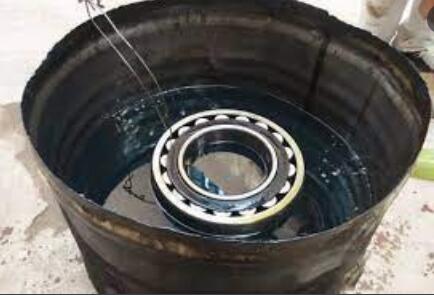When disassembling the bearing for maintenance, first record the appearance of the bearing, confirm the remaining amount of lubricant, take a sample of the lubricant for inspection, and then clean the bearing. The selected cleaning agent, generally speaking, the anti-rust oil sealed on the bearing can be cleaned with a solvent-based cleaning agent. If there is a thicker anti-rust oil on the bearing, you can first use a solvent-based oil cleaner for metal parts, heat it to dissolve and clean it properly, take it out after the surface anti-rust grease is dissolved, and then wipe it. When cleaning, you should first pinch the inner ring of the NTN bearing with one hand and slowly rotate the outer ring with the other hand until the oil on the rolling elements, raceways and cage of the bearing is completely washed off, and then clean the surface of the outer ring of the bearing. At the beginning of cleaning, it should be rotated slowly, swayed back and forth, and rotated too hard, otherwise the raceways and rolling elements of the bearing will be easily attached to dirt. When the number of bearing cleaning is large, it can be divided into two steps: coarse and fine cleaning. During rough cleaning, if the bearing is rotated with dirt, it will damage the rolling surface of the bearing, so care should be taken. In the rough cleaning oil, use a brush to remove grease and adhesions. After it is roughly clean, switch to fine cleaning. Fine washing is to carefully clean the bearing while rotating it in the cleaning oil. For bearings that are inconvenient to disassemble, wash them with a cleaning agent for parts to melt the old oil, and then use an iron hook or a small spoon to rinse off the remaining oil in the bearing. Be careful not to have an open flame when cleaning.
After the bearing is cleaned, carefully observe that there will always be some remaining oil in the raceways of the inner and outer rings, on the rolling elements and in the gaps of the cage. During inspection, scrape out the remaining oil with a clean feeler gauge, apply it on the thumb, and slowly rub back and forth with your index finger. If there is a rustle between your fingers, it means that the bearing has not been cleaned and should be washed again. Finally, hold the bearing in your hand, pinch the inner ring, and turn the outer ring to rotate horizontally (large bearings can be placed on the assembly table, the inner ring is cushioned, the outer ring is suspended, the inner ring is compressed, and the outer ring is rotated) to rotate Flexible, non-blocking, and no beating are qualified.After adding lubricant to the cleaned bearing, it should be placed on the assembly table with a clean cloth or paper pad underneath, and a plastic cloth on the top for assembly. It is not allowed to be placed on the ground or in a box. When moving the bearing, do not hold it directly by hand. Use canvas gloves or use a clean cloth to wrap the bearing before taking it. Otherwise, fingerprint rust may occur on the bearing surface. Bearings with dust caps or sealing rings on both sides and bearings coated with anti-rust and lubricating grease are already filled with grease during manufacture, so do not clean them before installation.






